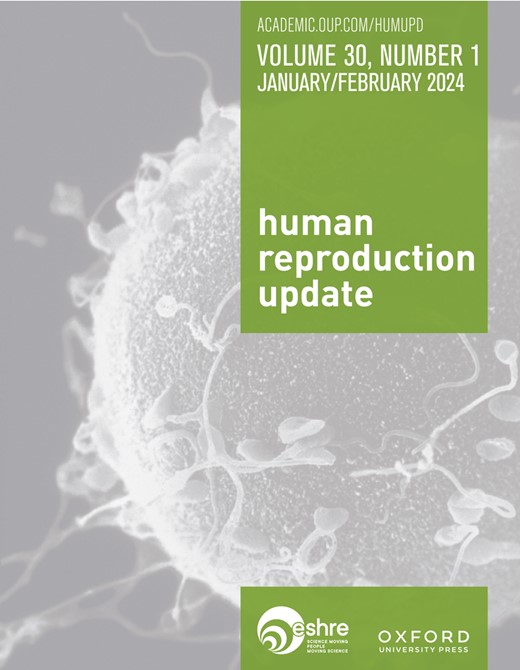Fertility in transgender and gender diverse people: systematic review of the effects of gender-affirming hormones on reproductive organs and fertility
IF 16.1
1区 医学
Q1 OBSTETRICS & GYNECOLOGY
引用次数: 0
Abstract
BACKGROUND Transgender and gender diverse (TGD) people seek gender-affirming care at any age to manage gender identities or expressions that differ from their birth gender. Gender-affirming hormone treatment (GAHT) and gender-affirming surgery may alter reproductive function and/or anatomy, limiting future reproductive options to varying degrees, if individuals desire to either give birth or become a biological parent. OBJECTIVE AND RATIONALE TGD people increasingly pursue help for their reproductive questions, including fertility, fertility preservation, active desire for children, and future options. Their specific needs certainly require more insight into the effects of GAHT on gonads, gametes, and fertility. This systematic review aims to provide an overview of the current knowledge on the impact of GAHT on gonads, gametes, fertility, fertility preservation techniques, and outcomes. SEARCH METHODS This review was registered in the PROSPERO registry under number CRD42024516133. A literature search (in PubMed, Embase, and Web of Science) was performed with a medical information specialist until 15 November 2024. OUTCOMES In all TGD people using GAHT, histological changes have been reported. Using testosterone GAHT, ovarian cortical and stromal changes were reported by various studies. In most studies, persistent activity in folliculogenesis can be concluded based on the descriptions of the follicle count, distribution, and oocyte retrieval yield. However, there may be a negative effect on the fertilization rate in the presence of testosterone. Reports of successful ovarian stimulation, fertilization, pregnancies, and live births have been published, describing cases with and without testosterone discontinuation. After using oestrogen GAHT, testes are reported to be more atrophic, including smaller seminiferous tubules with heavy hyalinization and fibrosis. Spermatogenic levels varied widely from complete spermatogenesis to meiotic arrest with spermatids, to spermatogonial arrest, Sertoli cells only, or even tubular shadows. Oestrogen and anti-androgen treatment causes higher proportions of sperm abnormalities (i.e. low total sperm count, low sperm concentration, poor sperm motility) or azoospermia. However, after cessation, this may be restored. WIDER IMPLICATIONS Although knowledge of the effect of GAHT is growing, blind spots remain to be uncovered. Therefore, additional research in this specific population is needed, preferably comparing outcomes before and after the start of GAHT. This may help to reveal the pure impact of GAHT on reproductive functioning. Research suggestions also include investigations into the reversibility of the GAHT effect, especially for those who start transition at a young age. Looking carefully at the presented data on GAHT effects on gonads and gametes, the correct advice is to assess and reassess reproductive wishes and preferences repeatedly, and also to explore individual fertility preservation needs during gender-affirming treatment, given the expanding knowledge and therapy opportunities. Finally, concerns regarding long-term health outcomes and quality of life of children born by the use of gametes preserved after exposure to GAHT require prospective follow-up studies.跨性别和性别多样化人群的生育能力:性别确认激素对生殖器官和生育能力影响的系统综述
背景跨性别者和性别多元者(TGD)在任何年龄都寻求性别确认护理,以管理与其出生性别不同的性别认同或表达。性别确认激素治疗(GAHT)和性别确认手术可能会改变生殖功能和/或解剖结构,在不同程度上限制未来的生殖选择,如果个人希望生育或成为亲生父母。目的和理由越来越多的TGD患者寻求生殖问题的帮助,包括生育能力、生育能力保存、对孩子的积极渴望和未来选择。他们的特殊需求当然需要更深入地了解GAHT对性腺、配子和生育能力的影响。这篇系统综述的目的是对GAHT对性腺、配子、生育能力、生育能力保存技术和结果的影响进行综述。本综述在PROSPERO注册中心注册,注册号为CRD42024516133。在医学信息专家的协助下进行文献检索(PubMed、Embase和Web of Science),直至2024年11月15日。结果:在所有使用GAHT的TGD患者中,组织学改变已被报道。使用睾酮GAHT,卵巢皮质和基质的变化被各种研究报道。在大多数研究中,卵泡发生的持续活性可以根据卵泡计数、分布和卵母细胞回收率的描述来推断。然而,睾酮的存在可能会对受精率产生负面影响。成功的卵巢刺激、受精、怀孕和活产的报告已经发表,描述了有或没有睾酮停药的病例。据报道,在使用雌激素GAHT后,睾丸萎缩更严重,包括更小的精管伴严重的透明化和纤维化。生精水平差异很大,从完全的精子发生到有精子的减数分裂阻滞,到精原细胞阻滞,仅支持细胞,甚至管状阴影。雌激素和抗雄激素治疗导致更高比例的精子异常(即精子总数低、精子浓度低、精子活力差)或无精子症。然而,戒烟后,这可能会恢复。更广泛的影响尽管对GAHT影响的认识正在增长,但盲点仍有待发现。因此,需要对这一特定人群进行进一步的研究,最好是比较GAHT开始前后的结果。这可能有助于揭示GAHT对生殖功能的纯粹影响。研究建议还包括调查GAHT效应的可逆性,特别是对那些在年轻时就开始转变的人。仔细观察目前关于GAHT对性腺和配子影响的数据,正确的建议是反复评估和重新评估生殖意愿和偏好,并在性别肯定治疗期间探索个人生育保护需求,因为知识和治疗机会不断扩大。最后,对使用经GAHT治疗后保存的配子出生的儿童的长期健康结果和生活质量的担忧需要进行前瞻性的后续研究。
本文章由计算机程序翻译,如有差异,请以英文原文为准。
求助全文
约1分钟内获得全文
求助全文
来源期刊

Human Reproduction Update
医学-妇产科学
CiteScore
28.80
自引率
1.50%
发文量
38
期刊介绍:
Human Reproduction Update is the leading journal in its field, boasting a Journal Impact FactorTM of 13.3 and ranked first in Obstetrics & Gynecology and Reproductive Biology (Source: Journal Citation ReportsTM from Clarivate, 2023). It specializes in publishing comprehensive and systematic review articles covering various aspects of human reproductive physiology and medicine.
The journal prioritizes basic, transitional, and clinical topics related to reproduction, encompassing areas such as andrology, embryology, infertility, gynaecology, pregnancy, reproductive endocrinology, reproductive epidemiology, reproductive genetics, reproductive immunology, and reproductive oncology. Human Reproduction Update is published on behalf of the European Society of Human Reproduction and Embryology (ESHRE), maintaining the highest scientific and editorial standards.
 求助内容:
求助内容: 应助结果提醒方式:
应助结果提醒方式:


